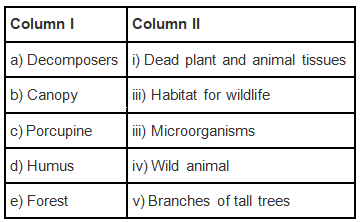NCERT Exemplar Solutions: Forests - Our Lifeline | Science Class 7 (Old NCERT) PDF Download
Multiple Choice Questions
Q.1. Which of the following serve as green lungs?
(a) The green pigment of the plants
(b) Forests
(c) Kitchen gardens
(d) Greenhouse gases
Ans: b
Explanation:
Plants release oxygen during photosynthesis, which is used by all the organisms. Plants help to maintain the concentrations of CO2 and Oxygen. Hence, they are called green lungs.
Q.2. Boojho visited a forest near his town with his classmates and his teacher. As they were entering the forest, their class teacher told them not to make noise in the forest as noise could disturb the
(a) birds
(b) animals
(c) both birds and animals
(d) plants
Ans: c
Q.3. Which among the following forest animals is the smallest?
(a) Fox
(b) Boar
(c) Bison
(d) Porcupine
Ans: d
Q.4. Which of the following has the strongest stem?
(a) A tree
(b) A creeper
(c) A climber
(d) A bush
Ans: a
Q.5. Which of the following is not prepared from the wood obtained from the forest?
(a) Paper
(b) Thermocol
(c) Matchsticks
(d) Plywood
Ans: b
Explanation:
Paper, Matchsticks and plywood are prepared from the wood obtained from the forest, whereas thermocol is prepared from synthetic fibres.
Q.6. Which of the following is not the name of a tree?
(a) Teak
(b) Sal
(c) Porcupine
(d) Kachnar
Ans: c
Explanation:
Porcupine is an animal whereas Teak, Sal and Kachnar are trees.
Q.7. Pick the option that gives the names of a tree and an animal, respectively, from the following.
(a) semal, hornbill
(b) sal, khair
(c) chinkara, blue bull
(d) neem, palash
Ans: a
Explanation:
Semal is the name of a tree, and hornbill is the name of an animal.
Q.8. Which of the products is not obtained from a forest?
(a) Honey
(b) Catechu
(c) Gum
(d) Ginger
Ans: d
Explanation:
Ginger is not obtained from forests. It is cultivated on farms.
Q.9. The branchy part of a tree above the stem is known as
(a) crown
(b) canopy
(c) sapling
(d) humus
Ans: a
Explanation:
The Crown is the top part of the tree. It consists of all the branches and leaves of the tree.
Q.10. Forests are not responsible for
(a) providing medicinal plants.
(b) maintaining the flow of water into the streams.
(c) creating flood conditions.
(d) absorbing rainwater and maintaining the water table
Ans: c
Explanation:
Forests dos do not create flood. Rather, they stop the flood by percolating the rainwater.
Very Short Answer Questions
Q.1. Paheli while moving in a forest observed that there was no noise pollution, though lots of heavy vehicles were passing from the nearby highway. Explain why?
Ans: In Forests, there will be no noise pollution because forests absorb noise.
Q.2. State whether the following statements are true or false. If false, give the correct statement.
(a) Forests influence climate, water cycle and air quality.
(b) In a forest, trees form the uppermost layer, followed by herbs. The shrubs form the lowest layer of vegetation.
(c) The forest keeps on growing and changing and can regenerate.
(d) Forests protect the soil from erosion.
Ans:
a) True
b) False- In a forest, trees form the uppermost layer, followed by shrubs. The herbs form the lowest layer of vegetation.
c) True
d) True
Q.3. Paheli wrote a food chain in the following way:
frog → eagle → insects → grass → snake
The chain is not in the correct order. Help her to write the food chain correctly.
Ans:
grass→insects→frog→snake→eagle
Short Answer Questions
Q.1. Give names of any four birds which you expect to see in a forest.
Ans: Jungle crow, myna, dove, kingfisher
Q.2. Two friends shared their experiences of their vacation trip to two different forests. Do you think they would have seen the same type of plants and animals during their respective trips? Give reason.
Ans: No, they might not see the same type of plants and animals in two different questions because climatic conditions in the two forests would be different, which would lead to variations in the types of plants and animals.
Q.3. “A bunch of seedlings were seen sprouting on a heap of animal dropping in a forest.” How do you think is the seedling benefited from the animal dung?
Ans: Growing seedlings obtain nutrients from decaying animal heaps.
Q.4. Match Column I with Column II

Ans:

Q.5. Deforestation may lead to floods. Why?
Ans: In the absence of trees, soil loses its water-holding capacity, which causes floods. Hence, deforestation leads to floods.
Q.6. Name any four useful products other than wood which we get from forests.
Ans: Gum, Spices, medicinal plants, catechu
Long Answer Questions
Q.1. Figure shows a part of a forest.
Write any three activities going on in the forest on the basis of this figure.
Ans:
- The leaves of the plants give out oxygen
- Plants consume carbon dioxide to prepare their food through photosynthesis.
- Decomposers play an important role in providing nutrients to plants.
Q.2. People say that nothing goes waste in a forest. Can you explain, how?
Ans: Nothing goes to waste in a forest for the following reasons
- Dry leaves and remains of dead animals are converted to a dark-coloured substance called humus. This provides nutrients to the plants.
- Dead animals become food for vultures, crows, jackals and insects.
- Broken branches of trees are used as fuel by the people living in the vicinity of the forest.
Q.3. Give any four factors which are responsible for the destruction of forests.
Ans: Factors responsible for the destruction of forests are
- construction of roads.
- construction of buildings.
- industrial development.
- increasing demand for wood.
Q.4. Draw a figure showing two animals, two birds and a few trees as a part of a forest.
Ans:

Q.5. All the needs of animals living in a forest are fulfilled. Justify this statement in a few sentences.
Ans: Animals are dependent on plants in the forest for many things. Plants provide 02 to the animals to respire. Animals are dependent on plants for food, either directly or indirectly. Herbivores obtain food directly from plants. Carnivores depend on herbivores for food. Trees in the forest provide shelter to forest animals. Hence, it is said that the needs of animals living in a forest are fulfilled.
Q.6. “Forests are our lifeline.” Write five sentences on this topic.
Ans: Forests are our lifeline for the following reasons
- Forests give oxygen to keep us alive.
- Forests absorb carbon dioxide, a gas that contributes to climatic changes, if its concentration increases in the atmosphere.
- Forests provide us with wood, gum, medicinal plants and spices.
- Forests save the soil from erosion.
- Forests help in maintaining the groundwater level.
- Forests avoid floods by increasing the water-holding capacity of the soil.
|
111 videos|286 docs|28 tests
|
FAQs on NCERT Exemplar Solutions: Forests - Our Lifeline - Science Class 7 (Old NCERT)
| 1. What are the benefits of forests to human life? |  |
| 2. How do forests help in maintaining ecological balance? |  |
| 3. What are the threats to forests around the world? |  |
| 4. How can individuals contribute to forest conservation? |  |
| 5. How can forests be managed sustainably for future generations? |  |





















